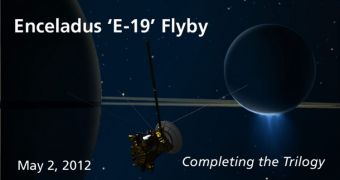Mission controllers at the NASA Jet Propulsion Laboratory (JPL), in Pasadena, California announce that the Cassini spacecraft will carry out a new flyby of the Saturnine moon Enceladus. This flight will be focused on imaging the object, and gaining more data of its gravitational pull.
The flyby will occur today, May 2, when the long-lived spacecraft will pass within 46 miles (74 kilometers) of Enceladus' surface. The primary goal of the flight will be to learn as much as possible about the moon's interior.
For this purpose, the spacecraft will be using its radio science experiment to analyze how it is being gently pulled towards the moon's surface. These slight variations in its orbital path can reveal areas underneath the surface where more mass is present.
The study will be conducted by allowing Cassini to fly on its own, with no power, while a steady radio link is secured between the spacecraft and the Deep Space Network (DSN) NASA operates on Earth.
This is the third in a trilogy of flybys dedicated specifically to understanding how mass is distributed under the thick ice sheet covering Enceladus. The object is one of the most interesting in the solar system, and also one of the most likely to support basic lifeforms.
The first two flybys dedicated to gravitational studies were carried out on April 28, 2010, and November 30, 2010, the JPL team explains. Experts add that the south pole is the most interesting target of all, since this is where plumes of water-ice and organic molecules are being ejected.
Enceladus features geyser-like structures called tiger stripes at its south pole. Past studies have revealed the likelihood that an ocean of liquid water exists under the moon's surface, which may have a basic chemistry similar to that of Earth's oceans.
By using the radio science experiments, researchers hope to be able to detect any potential subsurface liquid water, or perhaps warmer ice intrusions, which may help explain how the plumes occur, and what powers the geysers.
During today's flyby, Cassini will also use its composite infrared spectrometer instrument to observe the side of Enceladus that constantly points away from Saturn. The moon is tidally locked to the gas giant, meaning it always keeps the same face oriented towards it.
“Cassini will also be flying by Dione at a distance of about 5,000 miles (8,000 kilometers), enabling the imaging cameras to create several mosaic images of the icy moon, and the composite infrared spectrometer to monitor heat emission,” the JPL team concludes.

 14 DAY TRIAL //
14 DAY TRIAL //